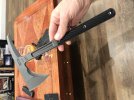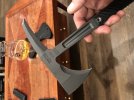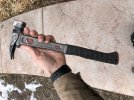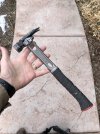Lighter means quicker and easier to maneuver ... heavier means more power, momentum and kinetic energy. You can't optimize both but need to find the right balance for your uses and application. I want to buy ONE high quality hawk. I don't have the opportunity to give various hawks a hands on evaluation ... I live in the Middle-of-Nowhere, New Mexico.
Usage would include an assortment of everyday tasks but one (probably rare) is of high priority:
Self defense against wildlife in gun free areas while hiking with my dog.
I said probably rare but I was actually attacked by a medium sized feral hog a few years ago, fortunately I was carrying a firearm. Open carry is legal here except in state parks (without a permit). I have a moral objection to buying a permit to exercise a constitutional right ... maybe I should compromise my principles and get the damn permit and put myself on the priority list for gun confiscation. Anyway, I have reduced my choices to a RMJ Kestrel (24 ounces) or a Kestrel feather (18 ounces).
Which one??? I am open to other suggestions but not interested in pepper spray, tasers, machetes, Bowies or spears.
Usage would include an assortment of everyday tasks but one (probably rare) is of high priority:
Self defense against wildlife in gun free areas while hiking with my dog.
I said probably rare but I was actually attacked by a medium sized feral hog a few years ago, fortunately I was carrying a firearm. Open carry is legal here except in state parks (without a permit). I have a moral objection to buying a permit to exercise a constitutional right ... maybe I should compromise my principles and get the damn permit and put myself on the priority list for gun confiscation. Anyway, I have reduced my choices to a RMJ Kestrel (24 ounces) or a Kestrel feather (18 ounces).
Which one??? I am open to other suggestions but not interested in pepper spray, tasers, machetes, Bowies or spears.





